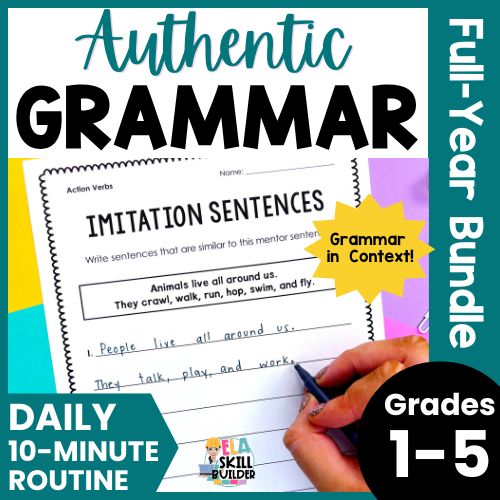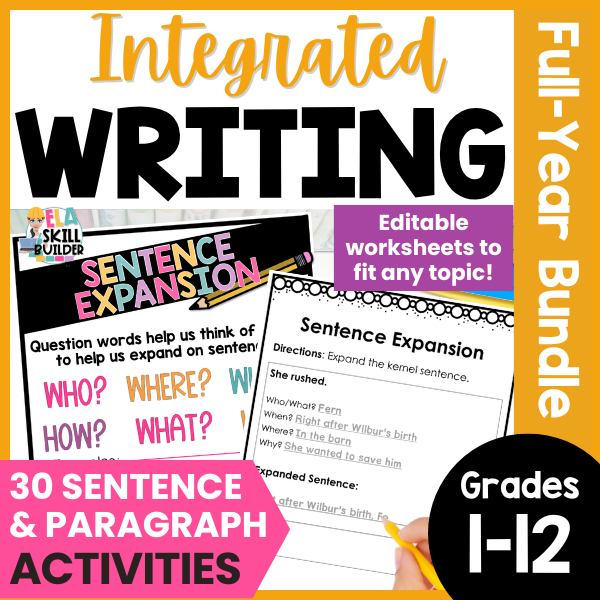

5 Writing Myths That Are Holding Back Your Students’ Growth
Only 27% of students in the United States perform at the proficient level or above in writing – a statistic that should set off alarm bells for every educator and administrator.
Writing is a foundational skill, critical not just for language arts, but for success across all academic subjects. And yet, in too many elementary classrooms, writing instruction continues to be underemphasized or pushed aside.
Why? A big part of the problem is rooted in outdated or misguided beliefs about what it takes to teach writing effectively. In this post, I’m unpacking 5 common myths about teaching writing that I believe are holding us back.
These myths are quietly shaping how we approach writing instruction, and not in a good way. If we want to truly support our students’ academic growth, we need to challenge these assumptions and start giving writing the time, attention, and intention it deserves.
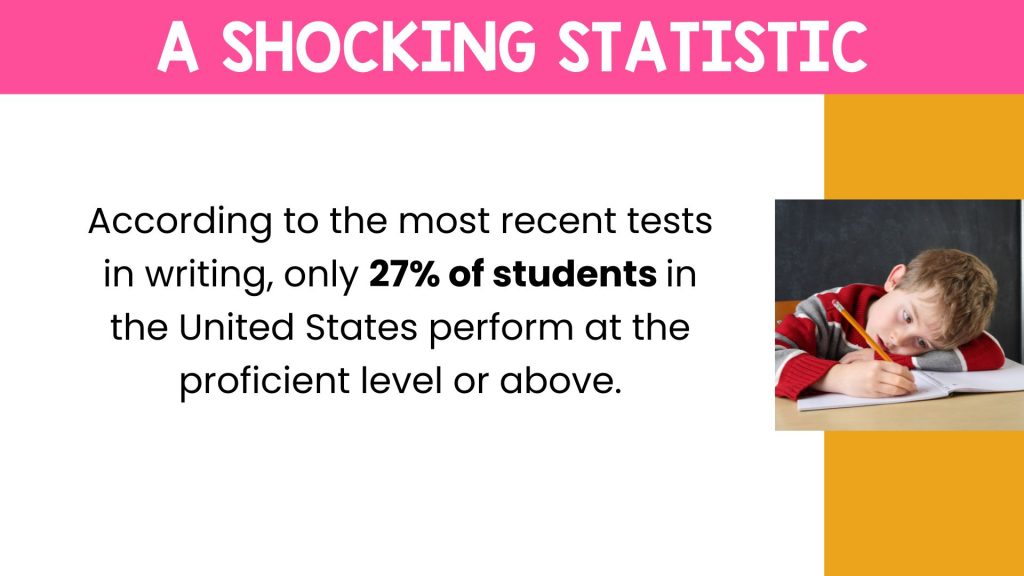
Myth #1: Writing Instruction Is Less Relevant Because of AI
With tools like ChatGPT and other AI platforms becoming more popular, it’s easy to wonder if students really need to learn how to write. But writing instruction is still essential — not just for school, but for life.
Students often write how they speak, using fragments, run-on sentences, or informal language that doesn’t follow standard rules of writing.
Writing instruction is critical because it teaches them how to transform those spoken patterns into clear, cohesive, and grammatically correct written communication.
Learning to write well also helps students build skills that AI can’t replace:
- Critical thinking: Helps students analyze, reflect, and make sense of complex ideas.
- Idea organization: Teaches how to present thoughts clearly and logically.
- Argument development: Builds the ability to support opinions with evidence.
- Sentence structure and grammar: Strengthens understanding of syntax and how language works.
- Effective communication: Prepares students to express themselves in writing across subjects and in the real world.
- Confidence and voice: Encourages students to take ownership of their thoughts and writing.
AI can be helpful, but it can’t replace the thinking, decision-making, and skill-building that happen when students write. Writing instruction is more important than ever.
Myth #2: Writing Instruction Is Less Important Than Reading Instruction
With the Science of Reading movement gaining so much attention – and rightly so – it’s easy for writing to get pushed aside. But here’s the thing: writing is reading’s closest partner. They’re deeply connected, and we’re missing a huge opportunity if we focus only on reading instruction.
Reading helps students take in information. Writing helps them make sense of it, organize their thinking, and communicate it back. Research continues to show that students become better readers when they also get consistent, high-quality writing instruction.
To better understand how writing strengthens reading skills, here are some key ways it supports students’ literacy development:
- Reinforces reading comprehension: Writing about what they’ve read helps students process and understand text more deeply.
- Builds vocabulary and language skills: Writing gives students opportunities to use new words and structures in context.
- Encourages critical thinking: Organizing ideas in writing pushes students to analyze, reflect, and explain their thinking.
- Improves retention: When students write, they remember what they learn more effectively.
- Supports overall literacy growth: Writing strengthens decoding, fluency, and content knowledge – all key reading skills.
We should absolutely keep prioritizing strong reading instruction, but writing deserves just as much attention. When we treat writing as a core part of our literacy block, not something extra, our students benefit across the board.
Myth #3: Teachers Need a Large Chunk of Time for Teaching Writing
As elementary teachers, we know how packed our schedules can get. With the increasing emphasis on reading, phonics, and math, it can feel nearly impossible to find a dedicated block of time just for writing.
While having a dedicated writing block is ideal, it’s not always realistic. The good news? Writing instruction doesn’t have to happen in isolation to be effective. In fact, it’s often more practical (and impactful) to integrate writing into our existing lessons.
Research shows that writing instruction can be effectively woven into subjects like science, social studies, and even math. When students are given the chance to write in a variety of contexts, they not only strengthen their writing skills but also deepen their understanding of the content they’re learning. By incorporating writing into other subjects, we’re able to make time for this critical skill without needing an extra block on the schedule.
Here are a few benefits of integrating writing across the curriculum:
- Improves content comprehension: Writing about what students learn in other subjects helps them process and retain the material more effectively.
- Reinforces key concepts: When students write in science, social studies, or math, they practice using subject-specific vocabulary and deepen their grasp of concepts.
- Boosts critical thinking: Writing pushes students to think critically about what they’re learning, making connections and organizing their thoughts in meaningful ways.
- Enhances communication skills: Regular writing practice across subjects helps students communicate more clearly and confidently, both in writing and speaking.
- Saves time: Instead of carving out extra time for writing, we can seamlessly incorporate it into existing lessons without sacrificing quality instruction.
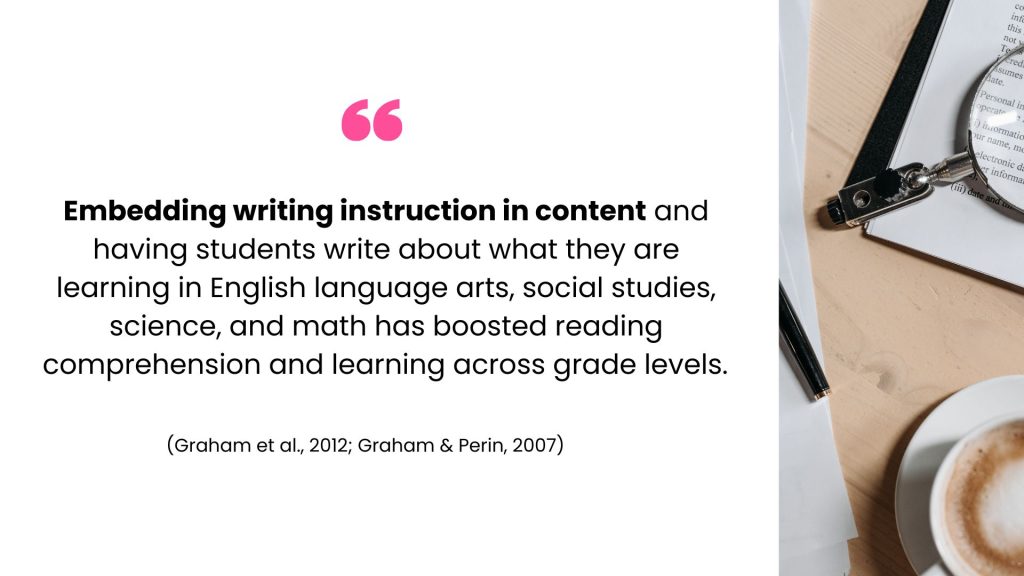
While the struggle to fit everything in is real, integrating writing into other parts of the curriculum is a win-win for both teachers and students. It allows us to prioritize writing without needing a completely separate block of time. Plus, students benefit from the added exposure to writing in a variety of contexts.
Myth #4: The more students write, the better writers they will become.
It’s a common belief that the more students write, the better writers they will become.
Many teachers feel the pressure to assign a large number of writing tasks, thinking that more practice will naturally lead to improvement. But just like giving students a lot of books doesn’t magically make them better readers, giving students endless writing assignments won’t automatically make them stronger writers.
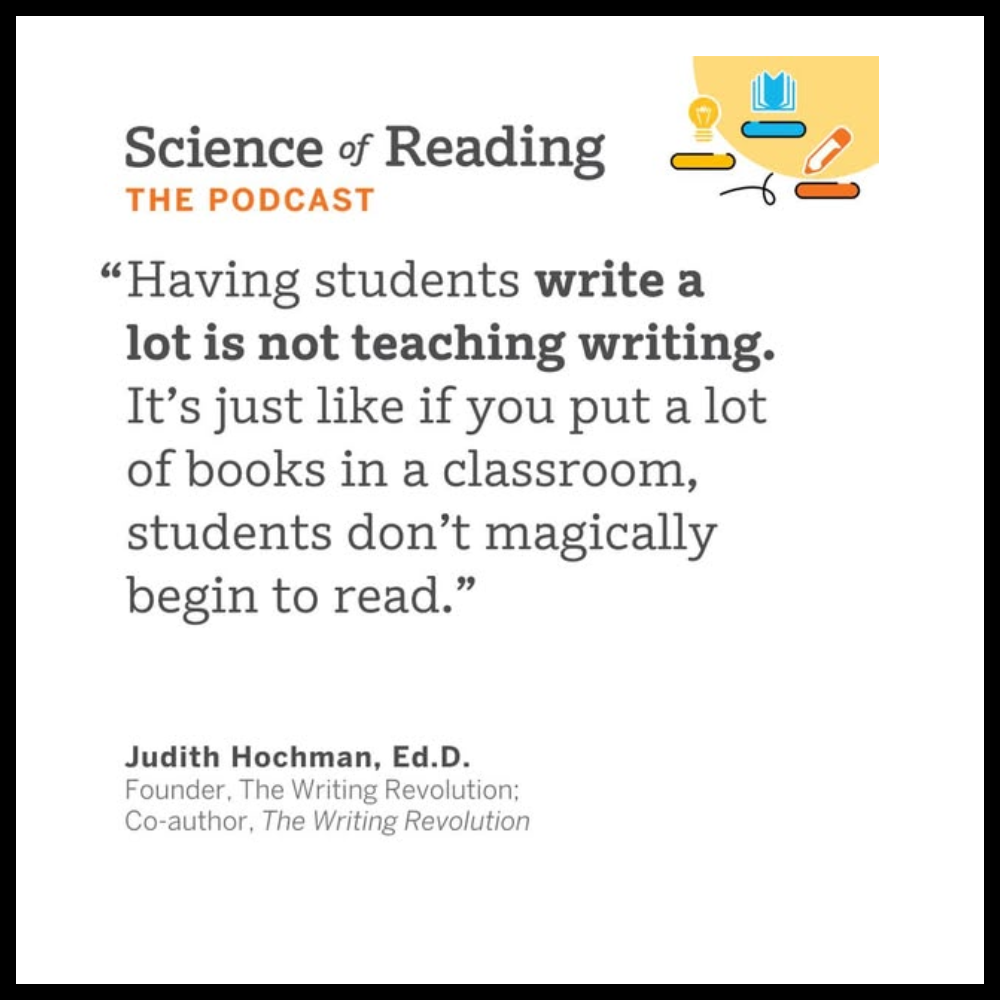
The truth is that quantity isn’t the key — quality is. In the elementary years, students need more than just opportunities to write; they need intentional, focused instruction that teaches them the foundational skills of writing.
One of the most important places to start is at the sentence level. It’s far more beneficial for young writers to develop the skills necessary to write cohesive, clear sentences and paragraphs than it is for them to focus on writing long stories without proper structure.
Here are some reasons why sentence-level instruction is so crucial in the elementary grades:
- Builds a strong foundation: Mastering sentence structure helps students understand how to organize ideas clearly and logically, setting them up for success in more complex writing tasks later on.
- Improves clarity and coherence: By focusing on sentence-level skills, students can learn how to connect ideas and ensure their writing flows smoothly, making it easier for readers to understand.
- Develops grammar and punctuation skills: Writing at the sentence level provides opportunities to practice essential grammar and punctuation rules, which are vital for clear communication.
- Enhances writing confidence: Students who master sentence structure gain confidence in their ability to express their thoughts and ideas clearly, which motivates them to tackle more complex writing.
- Prepares for paragraph writing: When students have a solid grasp of sentence construction, they are more equipped to move on to writing cohesive paragraphs, which is a key step toward longer, more complex writing projects.
Instead of focusing on assigning a lot of writing tasks, it’s more effective to provide students with targeted instruction that helps them build these essential writing skills one step at a time. By starting small, with a strong emphasis on sentence-level writing, we ensure our students have the tools they need to succeed as they continue to grow as writers.
Myth #5: Writing is Very Difficult for Students
Writing is a complex task that requires a lot of mental effort. It involves organizing thoughts, using correct grammar, choosing the right words, and structuring sentences – all at once. This high cognitive load can make writing seem overwhelming for many students.
However, just because writing is a complex skill doesn’t mean it’s out of reach for elementary students. In fact, it can be simplified with the right approach.
The key to successful writing instruction is reducing the cognitive load by breaking down the process into manageable chunks. Instead of expecting students to tackle everything at once, we need to focus on one specific skill or concept at a time. By providing clear, explicit instruction, modeling, and offering immediate practice, we can guide students step-by-step toward writing success.
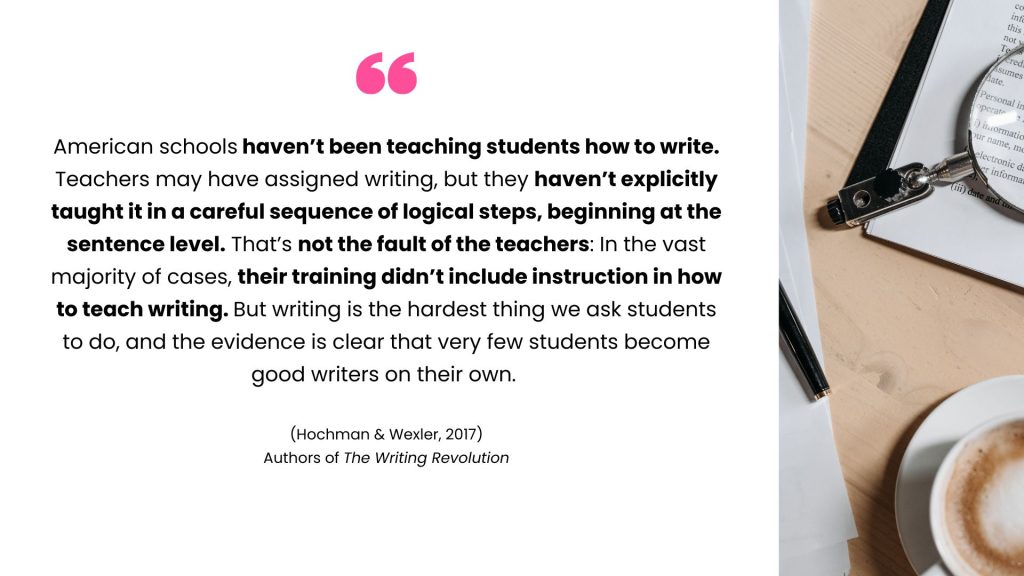
One effective way to approach this is by focusing on sentence-writing activities. Instead of giving students long assignments that require them to apply multiple writing skills all at once, break their learning down into bite-sized, focused tasks.
For example, one day, you might focus on sentence fragments and have students practice writing complete sentences. On another day, you might teach them how to use conjunctions to connect ideas. Narrowing the focus helps students master each skill and feel confident in their writing progress.
Here are some strategies to make sentence-writing activities more manageable:
- Break down sentence writing into smaller tasks: Focus on one aspect at a time, like correct punctuation, subject-verb agreement, or varying sentence structure.
- Use explicit instruction and modeling: Teach students how to apply each skill with clear examples and step-by-step guidance. Model writing sentences together so they can see how each concept fits into the writing process.
- Provide immediate practice: After introducing a new skill, give students time to practice writing sentences that apply what they’ve just learned. This reinforces the lesson and helps them gain mastery.
- Keep sentence-writing activities brief: Short, focused activities help students practice and build confidence without overwhelming them. For instance, writing just three sentences using conjunctions can be a powerful exercise.
- Offer ongoing feedback: As students practice writing sentences, give them specific, actionable feedback. Help them see where they’re excelling and where they need to improve, guiding them toward better sentence construction.
By keeping sentence-writing activities focused and manageable, students will develop the skills they need to become confident and capable writers. When we break writing down into smaller, manageable steps, students can build a strong foundation without feeling overwhelmed by the complexities of writing.
Try This: Sentence Expansion Activity
One of my favorite activities for building sentence skills is Sentence Expansion. It teaches students how to take a basic sentence and add detail, structure, and clarity.
Click here to grab the free sentence expansion lesson!
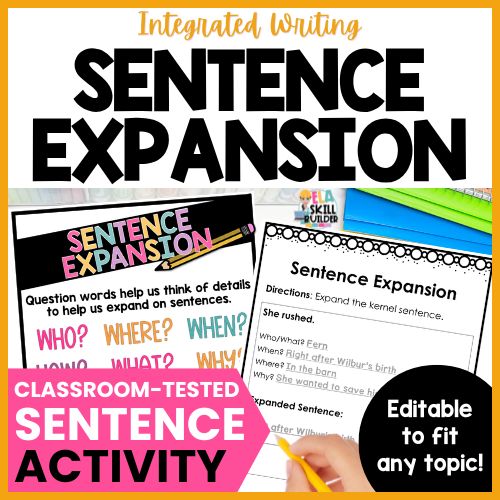
Conclusion
Teaching writing doesn’t have to feel overwhelming. By debunking these five myths, we can make writing instruction more effective and manageable for both teachers and students.
First, we need to prioritize writing alongside reading. Writing isn’t just an add-on; it’s an essential part of literacy. Then, by focusing on sentence-level skills and breaking writing down into small, focused tasks, we help students build confidence and mastery.
Remember, it’s not about giving students more work – it’s about giving them the right kind of instruction. With clear, explicit teaching and manageable writing activities, we can set our students up for success. Writing is a skill they can learn, and with your support, they will thrive.
About Jen Goasdone
Jen Goasdone, the owner of ELA Skill Builder, is a dedicated educator committed to empowering teachers with simple, research-based strategies for effective writing instruction. With a focus on making ELA teaching easier and more impactful, Jen helps students build a strong writing foundation that will serve them for years to come. Passionate about both teacher and student success, she strives to make writing instruction enjoyable and effective for elementary students.
Related Posts


Hey Teachers,
I'm Jen from
ELA Skill Builder!
My mission is to empower elementary teachers like you with the tools and confidence to teach writing effectively, so your students can grow into strong, capable writers.
Best Sellers!
Writing resources
Features explicit writing workshop lessons for narrative, informational, and opinion writing.
Grammar resources
Features a simple weekly routine that teaches grammar in context in just 10 minutes a day.
writing prompts
Features 810 prompts designed to strengthen paragraph writing skills all year long!
cross-curricular writing
Features 30 sentence and paragraph activities inspired by The Writing Revolution that fit any subject.
coupon code
Get 15% off Your First Purchase
free lessons!
Grab 5 free prewriting lessons to kick off your narrative writing unit – all materials included!
jOIN A COMMUNITY
writing training
Features 4 hours of video lessons designed to help you run a structured, effective, and engaging writing block.
free gramamr routine!
Features a free 5-day routine for teaching any grammar skill in context, in just 10 minutes a day!
free SENTENCE ACTIVITY
Features a free, editable sentence activity that helps students expand sentences for any topic.
contact jen!
Got questions? Fill out this contact form, and I’ll get back to you as soon as possible.




